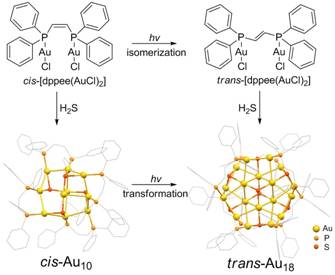Much attention has been paid to the investigation of polynuclear gold(I) complexes through gold(I)∙∙∙gold(I) interaction-driven self-assembly. Gold(I)∙∙∙gold(I) interaction, which has bond strengths similar to that of hydrogen bond, has not only supported their diverse structures and nuclearities, but also endowed them with attractive structure-dependent photophysical properties. However, an in-depth understanding of the assembly processes and mechanisms is still not clear for most of the cases. A team from The University of Hong Kong has tried to uncover the information on the assembly processes and the mechanisms by the incorporation of stimuli-responsive functionalities into polynuclear gold(I) complexes. An unprecedented cluster transformation involving a change in the cluster nuclearity has been mediated by light. Their research has been published in the Journal of the American Chemical Society (JACS) in 2015.
By introducing a photosensitive 1,2-bis(diphenylphosphino)ethene (dppee) into the polynuclear cluster system, photo-induced cis-trans isomerization behavior, together with structure and nuclearity switching behavior, had been observed in the polynuclear gold(I) cluster system. The decagold(I) cluster (Au10) could be quantitatively transformed into the octadeca-gold(I) cluster (Au18) in solution, mediated by the transformation of the organic ligands from cis- to trans-dppee, which could be monitored by 31P{1H} NMR, UV-vis absorption and emission spectroscopy.
The determination of the crystal structures of these polynuclear clusters plays a key role in the understanding of the structural reconfiguration process. The structural information unambiguously reveals the existence of isomerization and structural transformation. In addition, based on the crystal structures and other spectral results, the mechanisms of the assembly and transformation processes are disclosed. This work shows promises to the uncovering of the nature and the mechanism for the formation of polynuclear gold(I) clusters.

Photoinduced isomerization-driven structural transformation process and structures of polynuclear Au10 and Au18 clusters. Upon photoirradiation, isomerization of the organic ligands, 1,2-bis(diphenylphosphino)ethene (dppee) from the cis to the trans form in polynuclear gold(I) sulfido clusters, led to the structural transformation of the decagold(I) cluster to the octadecagold(I) cluster. Supported and driven by Au(I)···Au(I) bonding interactions, the nuclearity and symmetry of these clusters were largely different from each other, resulting in completely distinct photophysical features.
This work represents the first example of the tuning and the change of nuclearity of the polynuclear gold(I) clusters induced by photo-irradiation and such photoswitchable transformation of high-nuclearity gold(I) clusters is the first of its kind. The structure of polynuclear gold(I) clusters was obtained at 3W1A beamline of BSRF. This work has provided new insights and a new strategy to the self-assembly of polynuclear gold(I) clusters and the development of novel luminescent functional materials at the molecular cluster level. The current work demonstrates that with a fine and delicate balance of various factors, the assembly, structures and nuclearity of the gold(I) clusters could be judiciously modulated and controlled. The present work is also anticipated to provide deeper insights into the design and assembly of polynuclear gold(I) complexes and their structure-property relationships. The photosensitive and luminescent properties of these polynuclear gold(I) clusters have rendered them promising candidates for applications as novel photochromic materials.
Article:
Liao-Yuan Yao and Vivian Wing-Wah Yam* Photoinduced Isomerization-Driven Structural Transformation Between Decanuclear and Octadecanuclear Gold(I) Sulfido Clusters. Journal of the American Chemical Society, 137(2015), 3506−3509.


